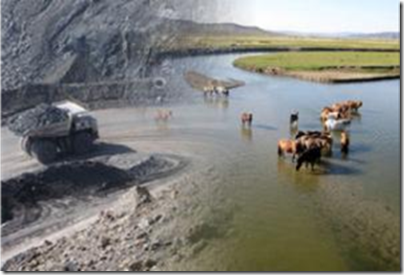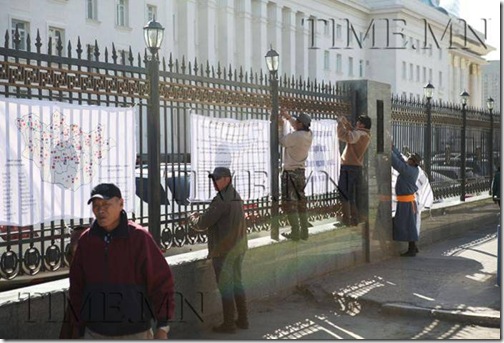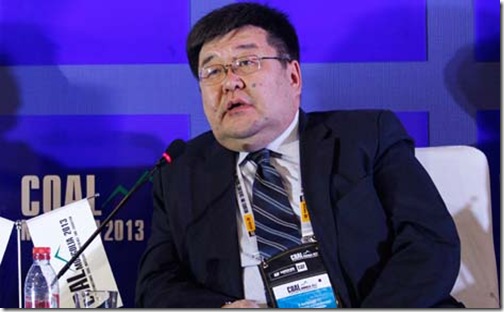Mongolian Mining Journal published a very informative description of changes proposed to the “Law with long name” with a promising title “End of confusion over “long-titled” law in sight”
We publish a shortened version with RwB comments. Aslo see THE SHORT HISTORY OF THE LAW WITH LONG NAME
SEPTEMBER 16 PROTEST AGAINST LAW AMENDMENTS
The Government’s main concern is how to meet the claims of companies who say their interests have been unfairly violated. That is why the Government wants to pass the Regulatory Law, which seeks to draw a line between licenses issued before and after July 16, 2009, the day the long-titled law came into effect, and also to differentiate between prospecting(exploration) licenses and mining ones.
The amendments would have mining licenses legally issued before the passing of the law to remain valid. The 346 mining licenses that are to remain in force will be given a choice. They can operate only if they agree to full and proper post-closure rehabilitation. Those who may not agree to the rehabilitation terms will be allowed to surrender their license, but will be allowed to leave only after rehabilitation of the land already affected. They will also not be entitled to any compensation.
License holders willing to continue operations are to submit a request, which will be processed under terms set out in the draft amendment. To enable the Regulatory Law to be drafted, the Ministry of Environment and Green Development slightly changed the definition of what constitutes the border of the protected regions, and it will now first make sure that the continuing operations will not be in areas still shown as protected. The other assessment will be made jointly by the Ministry of Mining and the Ministry of EGD to determine whether the amount of mineral resources estimated to be found by prospecting is enough to pay for adequate ecological reclamation following mining activity. If the request is seen to be viable on both counts, the company will then be asked to give a guarantee that it is capable of undertaking the rehabilitation work according to standards set by the Ministry. After this, an agreement will be made between three parties — the Mining Authority, the company and the local authority, with the Province Governor representing the last.
RWB comment: The purpose of the amendments is to defer the implementation given unproven justification that government lacks capacity to compensate for the investments in mining in those areas. Full post-closure rehabilitation of ALL mining sites is clearly required by Mongolian Law and therefore all described rehabilitation measures should be implemented everywhere anyway. The key to the confusion is that the Government does not want to address issue of just compensation in proper manner and therefore fears legal action from license holders. So proposed decision is to exclude existing licenses from protection zones, which will severely weaken river and forest protection.
The proposed Regulatory Law asks for an advance cash deposit of 50 per cent of the total rehabilitation costs, and some form of guarantee covering the remaining 50 per cent.
RwB comment: This requirement should more appropriately be applied to ALL mining operations in the country. Present requirement to put forward 50% of annual rehabilitation costs is absolutely insufficient to ensure proper rehabilitation.
The present law affects 10 types of minerals, but most of it is gold, with nearly 200 of the 346 mining licences and 316 of the 789 prospecting licenses pertaining to it. Gold companies have to submit all the gold they mine to the Mongol Bank. The draft law is in pursuance of the Government desire to make this sale of gold a transparent process and also to increase exploration activities. The Ministry of Mining estimates that a total of 123.8 tons of gold — 27.4 tons in the placer deposits and 96.4 tons in the main deposits are sealed off by the present law. So far, 163 of the 242 license holders for gold deposits have submitted their request to continue.
RwB comment: The previous Government of Mongolia in November 2010 announced that 254 placer gold mining licenses are irreversibly revoked. Now they somehow resurrected with the help of new government.
Placer gold mining is the primary threat for rivers and the main reason for the emergence of this Law and therefore it should not be allowed ever again. Such ban on mining in river valleys is already firmly established in nearby Northeast China. It is a great shame that Mongolian officials are ready to weaken protection of key resources in exchange for short-term placer gold mining boom promised by the Gold Mining Association. Placer gold mining is an ancient outdated technology which is being rapidly outcompeted by various hard-rock mining techniques that typically are not located in river valleys.
The draft Regulatory Law has no separate directives for prospecting licenses issued before the law came into force, treating them on par with mining licenses. The Ministry of Environment was more concerned with mining licenses.
B.Batkhuu , director of the Policy Implementation Department at the Ministry of Mining, had argued that prospecting is risky work, with no guarantee of success, and so the 789 valid prospecting licenses should be allowed to continue work until these expire in 2018. The only restriction he supported was to prohibit prospecting in areas too close to the banks of the river. His views were not favored by the Government.
Even then, the issue of prospecting will have to be discussed at the ensuing Parliament session, and there would certainly be demands for special treatment for projects which have seen substantial investment and also for those whose estimated resource amounts are high. Of the 789 prospecting licences, the investment amount for 84 exceeds MNT1 billion each. On the other hand, 386 licences have spent less than MNT50 million each.
RwB comment: This amendment would protect interests of large corporations (like Centerra Gold) who are likely sponsors of current backlash. Mongolian law already has provision for such special treatment of “strategic deposits” and likely there is no need to develop different additional mechanism to make such exceptions.
Only 77 of the 789 licences are on areas wholly forbidden, and the rest covers areas partly there, partly unencumbered. They can surrender the prohibited parts and stay clear of the law.
RwB comment: This is rather agreeable idea, but there should be a clear transparent procedure how the license owner can exchange his old license for the one where protection zones are excluded.
The law applies to 1,336 licences, 909 of them for prospecting, and 427 for mining. Similarly, the 1,728 licences originally included in the long-titled law became 1,336 because around 400 licences were surrendered in areas falling in the prohibited zones.
RwB comment: On one hand this shows severe lack of enforcement on the part of the Government, since in 4 years threat was removed only from 22% of areas designated as protected. At the same time it vividly demonstrates that in principle, even not being enforced the Law with the long name had a huge positiveenvironmental effect removing threats from 400 vulnerable areas. If the new democratic Government continued efforts to implement the law instead of finding excuses to weaken it, then, even with the same pace, in just a decade or two all licenses in protected zones could be surrendered by mining industry.
The number of frozen licenses has kept changing because of incomplete demarcation of the borders of prohibited areas. Non-professionals like soum governors had had a hand in preparing the list, and this had led to mistakes.
The Ministry of Mining had suggested prohibition of mining only in water source areas, but the Ministry of Environment and Green Development was firm on retaining the ban on forest areas as well. The revised Law on Water allows the Ministry of Environment and Green Development to make an evaluation of the prohibitory borders and the respective local authorities will approve its decision. The Ministry, perceived as not being too mining-friendly, has been surprisingly accommodative this time and
many see this as surrender in a way. In a bid to restrict the prohibited area, the protected zone has been reduced to 200 metres from the original 400 metres. Nearly 100 licences will benefit from this, though final figures will be clear only when error-free geographic coordinates are published.
RwB comment: It is hard to understand what specific borders are discussed in the text. In the maps we received in 2011 the water protection zone for most watercourses and lakes was drawn with consideration to local conditions: floodplain width, relief, natural value and human use of river valleys and lakeshores. Only small streams which did not receive special attention had a generic 200-meter zone prescribed by the Law on Water aw anyway. If the text describes an attempt to replace such delineation by mechanical drawing of 200-meter water protection zone – this will result in a major weakening of protection measures. And in any case of prescribed width of water protection zone it should be measures outwards from outer border of the natural floodplain (which is very evident on space images).
Gold placer deposits are likely to be shut down, denying license holders access to an estimated 27.4 tons of gold. Several major investors suggested a compromise regulation that would allow mining if the river areas were rehabilitated to their original condition.
The Ministry of EGD justifies its stand by pointing out that environmental experts see a decade of drought now giving way to a decade of rain. Rising precipitation started in the summer of 2010 and is likely to continue until 2020. With so much area in the territory of Mongolia scarred by mining activities, rains give us a chance to work on rehabilitating these areas and to allow top soil to form, says D.Enkhbat, Director of Environment and Natural Resources Department at the Ministry of EGD. The Ministry of EGD’s position is to proceed with rehabilitation and reclamation work in the remaining few years of the pleasant cycle. The Government appears to accept the argument.
RwB comment: Here we fully support the Ministry of EGD – placer gold mining with heavy machinery forever changes the very geological composition of river valley, let alone other parts of ecosystem. Rehabilitation of rivers to the original condition is a myth designed by the industry. Therefore placer gold mining in rivers, lakes and their vicinity should be stopped in all areas.

The two opposing sides in the controversy over the long-titled law are, broadly speaking, companies and the civil society. Both are known to have carefully studied the draft Regulatory Law and are likely to have sent in their suggestions. Environmental organizations had come to an agreement with the working group on the need for a quick solution, but on the day the special session of Parliament began, they opposed amendments to the law and created chaos outside Parliament House, using guns. Their leaders were arrested. The companies, on the other hand, have approved of the general principle of the draft while seeking some change in a few articles.
There is an air of optimism that with some tweaking here, and some change there, the confusion generated by the long-titled law is finally going to be ended after four years. We have to tread carefully so as not to leave behind any scope for future controversy. Some major steps in breaking the deadlock would be, as we have shown, unambiguous demarcation of the prohibited zones, ensuring that licenses issued prior to the law’s passage operate strictly in accordance to the law, enforcing rehabilitation responsibilities, and solving the compensation issue equitably.
RwB comment: It is widely recognized that the government did not want to listen to the criticism from civil society groups and they were forced to use extreme forms of demonstration, probably violating the law. However if these new amendments will be happily agreed between the mining corporations and government bureaucracy (as this article suggests) they will have little legitimacy in the eyes of Mongolian society. This means that the conflict between ordinary people protecting their land and international corporations and allied officials will only exacerbate. There is still a narrow window of opportunity to restart proper dialogue about implementation of the Law, rather than about weakening it to the point of uselessness.
Our fair land must prosper to everybody’s benefit and not be subject to unrestricted depredation. Some 27.2 million hectares of land or 17.3 per cent of the total territory of Mongolia are in the strictly protected regions and 41.7 million hectares or 26.7 per cent are for special local use. It is no great loss if nearly 50 per cent of the territory of Mongolia remains out of bounds for mining activities. Systematic and sustainable exploitation of what remains will be adequate.
RwB comment: These amendments are designed exactly to support “unrestricted depredation” of Mongolian rivers and forests.
Do not start new confusion by weakening the Law with long name!
Just implement existing legal provisions properly.



